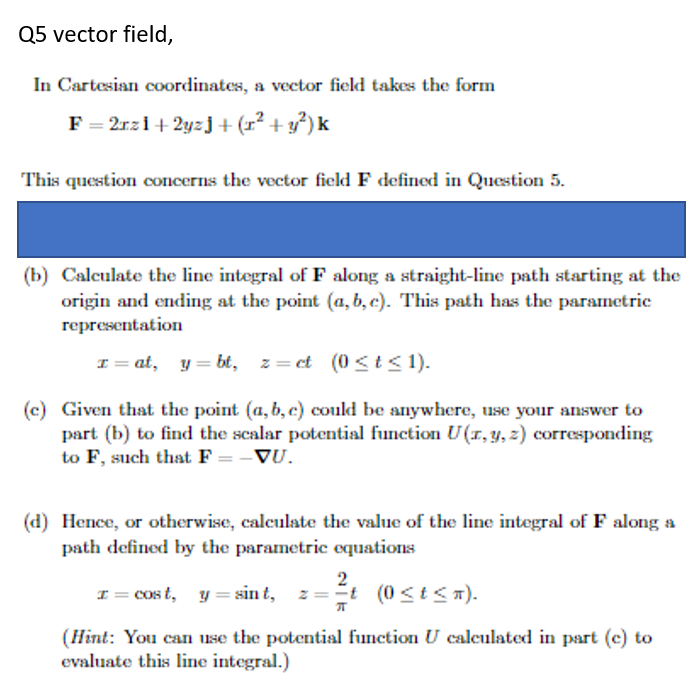Q5 vector field, In Cartesian coordinates, a vector field takes the form F = 2rzi+ 2yzj+ (r² +y*)k This question concerns the vector field F defined in Question 5. (b) Calculate the line integral of F along a straight-line path starting at the origin and ending at the point (a, b, c). This path has the parametric representation I = at, y= bt, z= et (0
Q5 vector field, In Cartesian coordinates, a vector field takes the form F = 2rzi+ 2yzj+ (r² +y*)k This question concerns the vector field F defined in Question 5. (b) Calculate the line integral of F along a straight-line path starting at the origin and ending at the point (a, b, c). This path has the parametric representation I = at, y= bt, z= et (0
Algebra & Trigonometry with Analytic Geometry
13th Edition
ISBN:9781133382119
Author:Swokowski
Publisher:Swokowski
Chapter8: Applications Of Trigonometry
Section8.3: Vectors
Problem 60E
Related questions
Question

Transcribed Image Text:Q5 vector field,
In Cartesian coordinates, a vector field takes the form
F = 2rzi+ 2yzj+ (r² +y*) k
This question concerns the vector field F defined in Question 5.
(b) Calculate the line integral of F along a straight-line path starting at the
origin and ending at the point (a, b, c). This path has the parametric
representation
I = at, y = bt, z= et (0 <t < 1).
(c) Given that the point (a, b, c) could be anywhere, use your answer to
part (b) to find the scalar potential function U(1,y, 2) corresponding
to F, such that F = -VU.
(d) Hence, or otherwise, calculate the value of the line integral of F along a
path defined by the parametric equations
I= Cos t, y = sin t, z
2
z=t (0 <t<n).
(Hint: You can use the potential function U calculated in part (c) to
evaluate this line integral.)
Expert Solution
This question has been solved!
Explore an expertly crafted, step-by-step solution for a thorough understanding of key concepts.
Step by step
Solved in 4 steps

Recommended textbooks for you

Algebra & Trigonometry with Analytic Geometry
Algebra
ISBN:
9781133382119
Author:
Swokowski
Publisher:
Cengage

Elementary Linear Algebra (MindTap Course List)
Algebra
ISBN:
9781305658004
Author:
Ron Larson
Publisher:
Cengage Learning

Algebra and Trigonometry (MindTap Course List)
Algebra
ISBN:
9781305071742
Author:
James Stewart, Lothar Redlin, Saleem Watson
Publisher:
Cengage Learning

Algebra & Trigonometry with Analytic Geometry
Algebra
ISBN:
9781133382119
Author:
Swokowski
Publisher:
Cengage

Elementary Linear Algebra (MindTap Course List)
Algebra
ISBN:
9781305658004
Author:
Ron Larson
Publisher:
Cengage Learning

Algebra and Trigonometry (MindTap Course List)
Algebra
ISBN:
9781305071742
Author:
James Stewart, Lothar Redlin, Saleem Watson
Publisher:
Cengage Learning